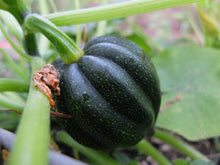10 seeds.
Matures in 85 days.
Planting companions: Dill, Swiss chard, borage, beet, chamomile, celery, shallot, endive, bean, lettuce, marjoram, mint, onion, oregano, potato, rosemary, arugula, thyme, sage.
Squashes traditionally grew in Native American gardens alongside corn and beans; this group of plants, known as the 'three sisters,' mutually benefited each other.
Unsuitable neighbors: Garlic, potato, ground cherry, chives, pumpkin, squash, fennel, strawberry, summer savory, tomato, ...
The vines of this winter squash produce medium-sized, heavily ribbed, olive-green vegetables with golden-yellow flesh. They can measure about 5'' in diameter and weigh up to 1.5 pounds, excellent for cooking and storing well.
Start your squash seeds indoors four weeks before the last expected ground frost. Squashes don't like to be transplanted, so opt for a large peat pot. Sow 2 seeds per pot and select the strongest when the time comes. About a week before the last frost, start acclimating your plants to outdoor life. When the soil temperature is around 18°C (65°F), transplant them into a very rich and well-drained soil at 8 to 10 feet apart. You can also sow your seeds directly in the garden; wait for the soil to reach a temperature of 21°C (70°F) and sow them at a depth of 1/2 inch.
Ensure to keep the soil consistently moist, and don't hesitate to use mulch to retain moisture and control weeds, in addition to keeping your squashes clean. When watering, avoid watering the leaves, as mold and fungi can develop. Cover your plants if the temperature drops to freezing.
Harvest them when the stem starts to dry, and the skin becomes too tough to pierce with a fingernail. Because cold weather can damage squashes, they should be harvested before the first frost. Cut the stem with a sharp knife, leaving a length of 2-3 inches. Do not carry the squash by the stem; if the stem breaks, it causes rapid deterioration of the squash. Use it as soon as possible. Cure the squashes in the sun or in a dry place until the stem dries; do not wash those you intend to store.




